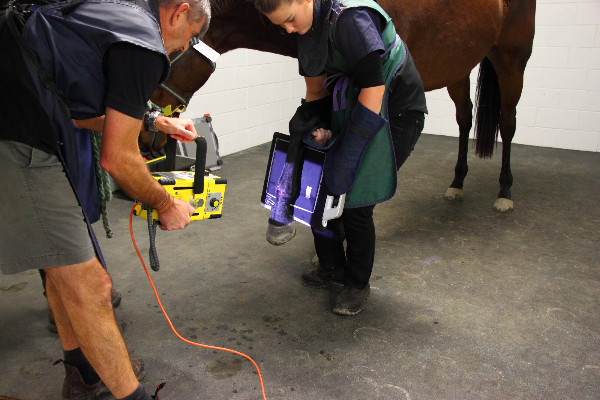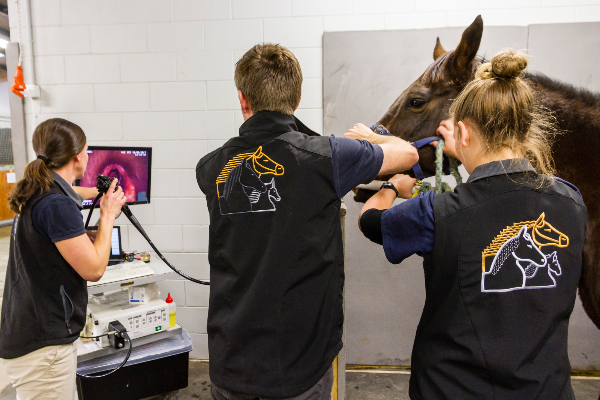Home | Equine Services | Diagnostic Imaging
Diagnostic Imaging
Accurate diagnosis of injuries, illnesses, and poor performance is made easier with the use of modern diagnostic imaging equipment. At Cambridge Equine Hospital, we have a full range of diagnostic equipment, and veterinarians who are highly skilled in their operation.
Radiography We have several digital radiography units, which produce excellent quality radiographs. These units are fully portable, so as long as there is flat, relatively dark area with a good power supply, we can generally come and take the radiographs on site. We are able to visualise the images instantly, often allowing a rapid diagnosis to be made. The radiographs are then reviewed on a high resolution computer screen back at the clinic, as this will highlight subtle lesions which may not be able to be seen on the laptop. We have several digital radiography units, which produce excellent quality radiographs. These units are fully portable, so as long as there is flat, relatively dark area with a good power supply, we can generally come and take the radiographs on site. We are able to visualise the images instantly, often allowing a rapid diagnosis to be made. The radiographs are then reviewed on a high resolution computer screen back at the clinic, as this will highlight subtle lesions which may not be able to be seen on the laptop.All our veterinarians are very experienced with radiography, and the practice taking a large number of high quality weanling, yearling, and Ready To Run sales repository radiographs each year. We pride ourselves on the quality and consistency of our radiographs. Dr. Murray Brightwell has been instrumental over a number of years in providing continuing education to veterinarians around the country with regards to taking high quality radiographs, and in 2017 Dr. Craig Lawrence was asked by the NZEVA to present the Radiography Roadshow to a number equine veterinarians from Auckland to Invercargill. |
|
|
UltrasoundUltrasound examination allows us to visualise a range of soft tissue s tructures within the horse. We have two high quality Mindray portable ultrasound machines, which were awarded the German Reddot Award, the world's greatest honour for industrial design. As you would imagine, they provide extremely clear images of many body parts including tendons, ligaments, vertebral facet joints, joint capsules. tructures within the horse. We have two high quality Mindray portable ultrasound machines, which were awarded the German Reddot Award, the world's greatest honour for industrial design. As you would imagine, they provide extremely clear images of many body parts including tendons, ligaments, vertebral facet joints, joint capsules.Ultrasound examination is very valuable for assessing lameness originating in the soft tissues, and can also be used to monitor healing of lesions. In addition to this, they are also able to image parts of the chest and abdomen, and can provide very useful information in the clinical examination of these areas. |
|
|
Videoendoscopy Cambridge Equine Hospital has 2 video-endoscopes, one of which is portable and able to be used in the field. This enables the televised examination of internal structures such as the upper respiratory tract or internal reproductive tract. Electronic recording of the examinations allows for a more controlled and objective assessment of endoscopic findings. Cambridge Equine Hospital has 2 video-endoscopes, one of which is portable and able to be used in the field. This enables the televised examination of internal structures such as the upper respiratory tract or internal reproductive tract. Electronic recording of the examinations allows for a more controlled and objective assessment of endoscopic findings.We are now also able to offer a portable videoendoscopy service. This is particularly useful for accurately monitoring the progression of lesions, or to enable 2nd opinions without having to scope the horse repeatedly. There is now a high demand throughout Australasia for yearlings and 2 year olds to have a videoscope examination performed within 7 days of sale. Cambridge Equine Hospital has set the benchmark for quality in these examinations, with extremely positive feedback from both vendors and the veterinarians viewing these videos. If you have any enquiries regarding this service please contact the clinic. Another advancement in endoscopy is the Dynamic Respiratory endoscope (DRS). With this system, the scope is positioned in the throat and then fixed to the horse, allowing visualisation of the upper respiratory tract while the horse is working. This enables us to diagnose dynamic conditions that occur during exercise (eg horses that "flip" their soft palates) but which are not usually seen at rest. Please see the Resources section of the website for more information. |
|
|
Nuclear ScintigraphyCambridge Equine Hospital are proud
 to be a founding partner of the Cambridge Stud and Bradninch Trust Nuclear Scintigraphy Centre. Cambridge Equine Hospital are the only practice in NZ with on-site MiE scintigraphy, and the unit is one of only 4 of its kind in the Southern Hemisphere. Scintigraphy is a great diagnostic tool which is particularly useful in lameness and poor performance investigations. to be a founding partner of the Cambridge Stud and Bradninch Trust Nuclear Scintigraphy Centre. Cambridge Equine Hospital are the only practice in NZ with on-site MiE scintigraphy, and the unit is one of only 4 of its kind in the Southern Hemisphere. Scintigraphy is a great diagnostic tool which is particularly useful in lameness and poor performance investigations.Scintigraphy involves injecting the horse with a radioactive substance which binds to areas in the bone that are actively remodelling. It enables us to see subtle changes that are not visible on radiographs. It is very good for the early identification of stress fractures (therefore preventing catastrophic breakdown) as well as low grade, intermittent, or upper limb lameness. |
